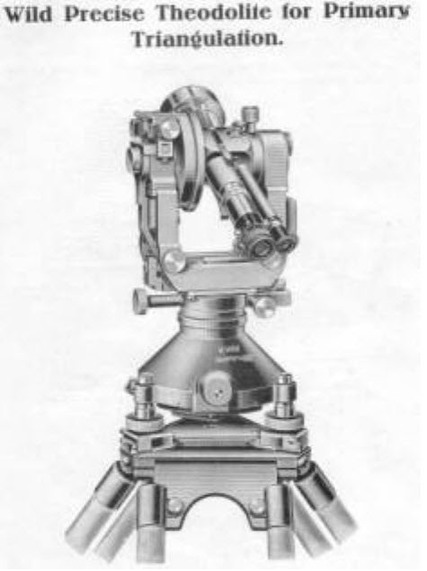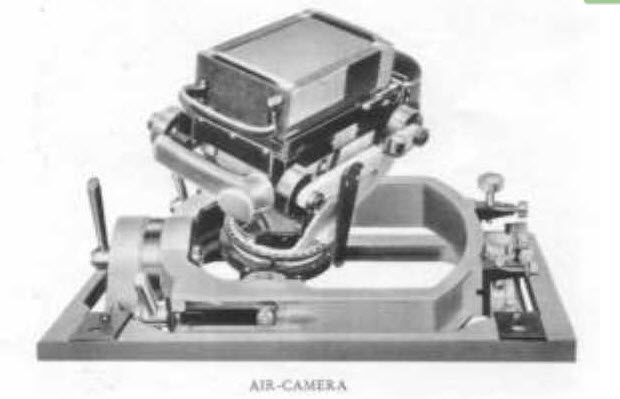When Heinrich Wild moved in the spring 1921 to Heerbrugg he realized his plans by founding, together with Dr. Robert Helbling from Flums and Jacob Schmidheiny from Heerbrugg the “Heinrich Wild, Werkstätte für Feinmechanik und Optik, Heerbrugg”. This organization was created April 26, 1921.
Dr. Wild then constructed in his own workshop a theodolite similar in design to the original Th1 but improved in many respects. It is widely known today by the name, Wild Universal Theodolite (or later as the famous WILD T2).

Wild T2
In March 1923 the first instrument for sale was finished
The following are amongst the improvements in this form of the instrument:
- Changing over of the images of the horizontal and vertical circles by means of a changeover prism.
- Bringing the eyepiece of the microscope immediately alongside that of the telescope.
- New system of packing the instrument in a metal case.
- Greatly increased precision of graduation and reading of the circles, rendering the instrument capable of replacing theodolites of twice its size of the old form.
A further improvement deserving of special mention is the new Arrangement for attaching the instrument to its tripod. Wild moved the point of suspension of the plumb-bob into the plane Of the feet of the leveling screws, thus permitting of the instrument being leveled without disturbing the centering over the station-point.
As an accessory to the Universal Theodolite the precision telemeter was constructed, to be placed over the objective, raking use of a plane-parallel glass plate as an optical micrometer.
Amongst further instruments designed and constructed by Wild may be mentioned:

the Wild telescopic alidade (later called Wild K1)


The level with circle, in which the circle is read of a special arrangement of scale-microscope


small Wild Precice Level No.II with horizontal Circle small Wild Precice Level No.II without horizontal Circle

Grosses Präzisions-Nivellier No. III
Large Wild Precice Level No.III

Der Präzisions-Theodolit, ähnlich dem Universal-Theodolit, aber von größeren Dimensionen und erhöhter Genauigkeit (später Wild T3 genannt)
The Precision Theodolite, of similar design to the Universal Theodolite, but of larger dimensions and increased accuracy (later called Wild T3)

Wild Präzisions-Telemeter für den Wild Universal Theodolit (Wild T2)
the Precise Wild Telemeter for the Wild Universal Theodolite (Wild T2)
After establishing his factory in Heerbrugg, Wild turned his attention to photogrammetry, and constructed an autograph differing from every existing construction in that the guide - rods were rigidly fixed to the plate-carriers. The solution of the problem here involved was first rendered possible by the invention of the correction-device for the automatic elimination of the projection-errors, which arise with this Arrangement.
It would take us too far afield to enter here on the numerous other interesting points of detail presented by the Wild Autograph.

the first Wild Autograph Wild A1

In 1922 Wild constructed a new phototheodolite with special ball and socket arrangements in place of the usual axes, whereby a much more squat construction could be achieved. By this Combination of the photographic camera with a precise theodolite, the successful phototheodolite was obtained, which is unique in the World and represents the most complete and perfect instrument of this kind which ever was seen.

In 1925 Wild brought out his Air Camera with improved objective 1:5 (improved definition at plate edges, freedom from distortion, less falling-off of illumination at plate-corners).
From this short summary it will be evident how largely the inventions and constructions of Wild have contributed to the development of geodetic instruments; but for his inventive and creative talent, the manufacture of geodetic instruments would not have undergone the epoch-making changes and the unexpectedly rapid progress of which the results are manifest today throughout the world.
In 1931 he moved to Zurich and leaved Wild Heerbrugg on 7.December 1932. But he was working as a independent designer and developer still for them till 1935.

